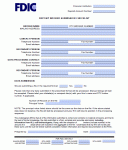The following is a listing of commonly asked questions and answers. If your specific question is not addressed below, please visit the Failed Bank List to locate a specific failed financial institution. Each failed financial institution page features contact information and other useful details.
1. In general, what steps do I as a Broker/As Agent need to do?
- Cease all activity on the affected deposit accounts as of the institution closing date.
- Notify all sub-tier brokers that the institution is closed.
- Request documentation of each individual account to support eligibility for pass-through insurance.
- Gather information from sub-tier brokers and submit to the FDIC.
2. What paperwork must I complete and/or submit in order for the FDIC to process my claim for deposit insurance?
- All Brokers/As Agents must complete an Affidavit of Agency Account including the Exhibit A and Exhibit B.
- All Brokers/As Agents must provide copies of their standard form of agency agreement OR, if no standard form of agency is used, then submit other written documentation supporting the agency relationship along with a copy of the customer’s statement.
- Load owner/investor information on a properly formatted and electronically uploaded file, USB/thumb drive, or DVD.
- All relevant affidavits and/or declarations.
Please note that in many closing situations the deposits cease earning interest from the day after closing so it is important that you submit the required documentation as soon as possible.
3. What must I complete for the Affidavit of Agency Account?
A single affidavit can be used to cover all of the accounts held by you as agent. Please be sure that the Affidavit is notarized and that Exhibit A indicates, for each owner/investor for whom you are acting as agent: the full name, address, and tax identification number. Also included should be the amount of principal (only) that each owner/investor owned in each account as of the closing date. Where you hold multiple agency accounts, please be sure to indicate the account number at the closed institution for each principal listed. A computer-generated customer ownership list may be substituted for the above Exhibit A, provided that all of the requested information for each owner/investor is included.
You should attach as Exhibit B to the Affidavit of Agency Account a copy of your standard form(s) of agency agreement(s) or, if there are no standard agreements, a copy of each agreement or other written documentation of the agency relationship as described in paragraph 3 of the Affidavit of Agency Account, along with a copy of the customer’s statement. Please also be sure to attach the documents requested in paragraph 4, if applicable.
4. What if I am acting as an agent for a broker who is also acting as agent for others?
Please have the secondary agent submit an Affidavit of Agency Account, completed and executed as described above, to document the second level agency relationship.
5. What if I have some questions about the Affidavits and Declarations? Where should I send the Affidavit and other requirements?
Please contact us by email at bdclaims@fdic.gov or by phone at 972-761-2575 (Nancy Clark) or 972-761-8580 (Jake Meyer).
6. What will the FDIC do with the list and file of my customers?
The FDIC will review the listing of owners/investors to determine the amount of insurance coverage due to each one. By federal statute, the FDIC is permitted to pay deposit insurance only up to the amount provided by law. In most cases, this is $250,000 per owner/investor.
The listing of owners/investors submitted by you will be loaded into the bank’s depositor database and sorted against those depositors and other broker-submitted files. For example, John Doe is one of your owners/investors and you disclose that he has $120,000 on deposit at the failed institution. John Doe also deposited $50,000 directly at the failed institution and another $125,000 through a separate broker. Our computer program will group these three accounts together and reflect that John Doe has $295,000 on deposit in the single ownership category. In accordance with the deposit insurance regulations, John is only insured for $250,000.
The FDIC processes the files submitted by brokers/as agents on a First-in First-out basis provided that: all required documentation is presented; the deposit balance on the file agrees with the information provided on the Broker/As Agent Submission Checklist and we encounter no problems with the data on the file. Insured funds are paid first on the deposits directly placed at the institution by the depositor. In this example, the $50,000 deposited directly with the closed institution will be paid in full and so will the $120,000 deposited through you since your information was the first received. The second broker will only be paid $80,000 of the $125,000 deposited through them and the remaining $45,000 will be deemed in excess of the insured limit. Subsequently, if John Doe has single ownership funds deposited through other brokers, those funds, too, will be deemed uninsured and a claim will need to be filed.
7. What happens if my investor has uninsured funds?
A customer with uninsured funds will be deemed a creditor of the failed institution and a Notice of Insurance Determination will be issued to you on their behalf as evidence of their approved claim. The Notice of Insurance Determination will be issued as soon as practical.
8. When will I be paid my insured deposits?
The FDIC’s goal is to pay insured deposits as soon as practical after receipt of a complete and error-free package. In the case of deposits placed through a depository organization, the funds will be paid to the depository organization with an emailed notification sent to the broker/as agent. For all others, funds will be paid directly.

